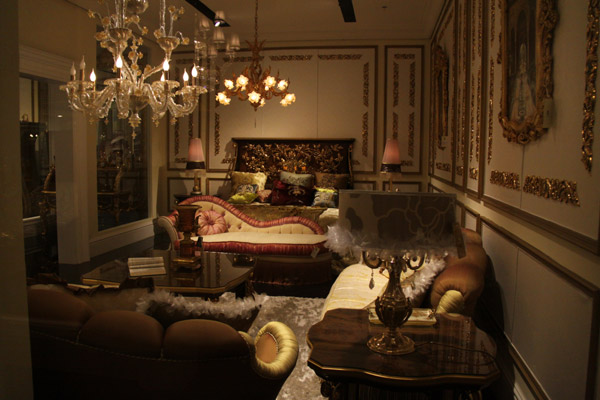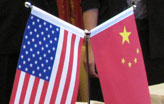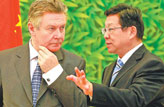Companies
Deciphering origins of the Da Vinci code
Updated: 2011-07-15 07:39
(China Daily)
Company accused of labeling domestic goods as foreign, He Dan and Yang Wanli report from Beijing, Gao Changxin from Shanghai.
It was about 1 pm on Monday and the Da Vinci store on Shanghai's Huaihai Road was open, but no customers were in sight. The company, established in Shanghai in 2000, sells luxury furniture, which means overseas brands and overseas prices.
 |
|
Panzhuang Xiuhua, general manager of Da Vinci in China, insists that all the Italian furniture displayed in her eight stores was made in Italy. She spoke on Wednesday at a news conference in Beijing. Zhu Xingxin / China Daily |
"We sell high-end furniture, imported from foreign countries," a saleswoman said. "They are purchased globally."
That's how the label actually read - "globally purchased" - on a silk-covered couch priced around 110,000 yuan ($16,975).
But the saleswoman could not say where it, or other pieces, had come from.
In Da Vinci's case, country of origin has become an important issue.
Chinese Central Television (CCTV) reported on Sunday night that some of Da Vinci's expensive furniture was not made abroad but in Dongguan, Guangdong province. And what the company called "rare wood" was, in some cases, partly polymer and other chemicals.
This is hardly the first time that a Chinese company has been accused of attaching false foreign identities to the goods they sell. A couple of examples:
The Order floor material company, which claimed to have been established in Germany in 1903, was proved in 2006 to be a Chinese company with a history of only eight years. Order was fined 7.4 million yuan for fraudulent marketing.
In 2008, Guangzhou Jiahe Cosmetics Manufacturing Co Ltd apologized for forging a Japanese background for its Marubi cosmetics. Jiahe, a Guangzhou-based Chinese company founded in 2002, had claimed it was a Sino-Japanese joint venture. Misleading advertising conjured up Japanese origins and a long history for the brand.
Suspicion, a probe
 |
|
Luxury furniture fills a showroom at the Da Vinci Group's store in Beijing. Country of origin for some of the company's goods is suspect. Zhu Xingxin / China Daily |
Early last year, a Beijing resident surnamed Tang spent more than 2.8 million yuan ($433,270) on about 40 pieces of furniture from Da Vinci. She did not hesitate to pay that much for furniture labeled "Cappelletti made in Italy." She said the salesperson promised that the Cappelletti brand is world-famous and that all the furniture Tang bought was made from natural and high-quality materials.
When the furniture was delivered, Tang said, it came with an unpleasant smell. The 100,000 yuan bed she had bought for her daughter was 1.2 meters wide, not the 1.5 meters described in the contract. A sales manager at Da Vinci Beijing explained that China's measurement standards are different from those in foreign countries, Tang said.
Tang sent the bed and a television table for a quality check by the National Center for Quality Supervision and Inspection of Furniture and Indoor Environment. The furniture did not meet three of its quality standards. The TV table was rated substandard because it was made of high-density fiberboard, not solid wood.
On Sunday, CCTV broadcast its investigation of Tang's case, and an employee of a furniture manufacturer in Guangdong said Da Vinci lied about where some of its furniture comes from. Video footage identified Peng Jie as the general manager of Dongguan Changfeng Furniture.
He said his company receives orders from Da Vinci and ships the made-in-China furniture from Shenzhen's harbor to Italy. The furniture later is delivered to Da Vinci's storehouse in Shanghai as made-in-Italy products, he said.
Peng said Changfeng has taken orders for Da Vinci since 2006 and produced three "brands" of furniture - Riva, Hollywood Homes and Cappelletti. Their trade, unknown to the owners of the Riva and Cappelletti brands, totaled about 50 million yuan last year, he said.
China Daily learned that Peng, the whistle-blower, was sacked on Monday "because he told lies to media about our company's relationship with Da Vinci", a male employee at Changfeng furniture said on the phone.
Peng was not Changfeng company's general manager but a salesman, the employee said. He also said Changfeng used to provide accessories or components for Da Vinci, but not whole pieces of furniture.
All hand-carved?
Da Vinci Group released a public statement on its website Sunday night saying, "All the Italian brand furniture that Da Vinci sells in China was produced and imported from Italy."
Da Vinci's four-story shop in Beijing exhibits furniture from more than 100 brands, nearly 60 percent of them Italian. The 20-square-meter showroom for Cappelletti is on the third floor. One 2-meter-wide bed is priced at 408,659 yuan after a 20 percent discount. The label states that the bed, a model called Emotion, was made in Italy of briarwood.
Zhao Ying, the store's sales manager, said on the CCTV report that all of the bed's sophisticated carvings are handwork. On Tuesday, a saleswoman told China Daily that's not entirely true - parts of some designs are too intricate for hand-carving. She said she didn't want to be identified for fear of losing her job.

Specials

China-US Governors Forum
The first China-US Governors Forum is held July 15 in the Salt Lake City, the United States.

My China story
Foreign readers are invited to share your China stories.

Rare earths export quota
China kept its export quota at almost the same level as last year.